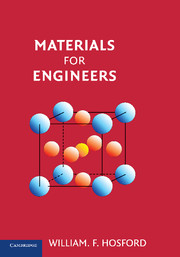Book contents
- Frontmatter
- Contents
- Preface
- 1 Introduction
- 2 Phases
- 3 Diffusion
- 4 Mechanical Behavior
- 5 Mechanical Failure
- 6 Annealing
- 7 Iron and Steel
- 8 Nonferrous Metals
- 9 Casting and Welding
- 10 Solid Shaping
- 11 Polymers
- 12 Polymer Processing
- 13 Glasses
- 14 Crystalline Ceramics
- 15 Powder Processing
- 16 Pottery and Concrete
- 17 Composites
- 18 Carbon
- 19 Fibers, Foams, and Porous Materials
- 20 Electrical Properties
- 21 Optical and Thermal Properties
- 22 Magnetic Materials
- 23 Corrosion
- 24 Modern Manufacturing Techniques, Surface Treatments, and Recycling
- APPENDIX 1 Wood
- APPENDIX 2 Miller Indices for Planes and Directions
- APPENDIX 3 X-ray Diffraction
- APPENDIX 4 Surfaces
- APPENDIX 5 Dislocations
- APPENDIX 6 Avrami Kinetics
- APPENDIX 7 Organic Chemistry
- APPENDIX 8 Average Molecular Weight
- APPENDIX 9 Bond Geometry in Compounds
- APPENDIX 10 Weibull Analysis
- Index
- Conversions
APPENDIX 1 - Wood
Published online by Cambridge University Press: 05 June 2012
- Frontmatter
- Contents
- Preface
- 1 Introduction
- 2 Phases
- 3 Diffusion
- 4 Mechanical Behavior
- 5 Mechanical Failure
- 6 Annealing
- 7 Iron and Steel
- 8 Nonferrous Metals
- 9 Casting and Welding
- 10 Solid Shaping
- 11 Polymers
- 12 Polymer Processing
- 13 Glasses
- 14 Crystalline Ceramics
- 15 Powder Processing
- 16 Pottery and Concrete
- 17 Composites
- 18 Carbon
- 19 Fibers, Foams, and Porous Materials
- 20 Electrical Properties
- 21 Optical and Thermal Properties
- 22 Magnetic Materials
- 23 Corrosion
- 24 Modern Manufacturing Techniques, Surface Treatments, and Recycling
- APPENDIX 1 Wood
- APPENDIX 2 Miller Indices for Planes and Directions
- APPENDIX 3 X-ray Diffraction
- APPENDIX 4 Surfaces
- APPENDIX 5 Dislocations
- APPENDIX 6 Avrami Kinetics
- APPENDIX 7 Organic Chemistry
- APPENDIX 8 Average Molecular Weight
- APPENDIX 9 Bond Geometry in Compounds
- APPENDIX 10 Weibull Analysis
- Index
- Conversions
Summary
Structure
Wood is composed of hollow cells that transport sap in the living tree. Annual growth rings are evident in the cross section of a tree trunk as shown in Figure A1.1. They are easily seen because faster growth in the spring results in larger cells (Figure A1.2). Softwoods come from conifer (e.g., pine, spruce, and fir) and hardwoods from broadleaf trees (e.g., oak, maple, hickory, poplar, and willow). Most hardwoods are denser and harder than softwoods, but there are exceptions. Douglas fir is harder and denser than willow and poplar.
Sapwood is the portion of the trunk through which sap is conducted. Heartwood is dead sapwood and is usually darker in color. The number of growth rings in the sapwood is between 20 and 40 for most hardwoods.
Bone-dry wood consists mainly of three compounds: cellulose (40 to 50%), hemicellulose (15 to 25%) in the cell walls, and lignin (15 to 30%), which holds the cells together. In a living tree, wood usually contains about 30% moisture. The shrinkage on drying varies with direction. Table A1.1 lists the shrinkage of several woods on drying to 6% moisture.
Because the shrinkage is greater in the tangential direction than in the radial direction, there is a strong tendency for a log to form radial cracks when drying, as shown in Figure A1.3. This tendency to split is aggravated because the outside dries before the inside.
- Type
- Chapter
- Information
- Materials for Engineers , pp. 239 - 243Publisher: Cambridge University PressPrint publication year: 2008



